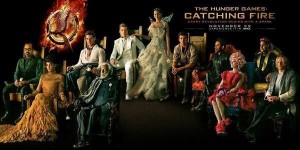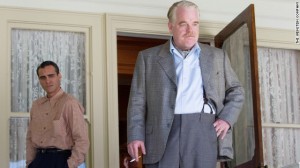Trailer: Mockingjay 2, the Last Chapter of The Hunger Games
Posted on July 26, 2015 at 11:33 pm
Posted on July 26, 2015 at 11:33 pm
Posted on February 2, 2014 at 6:09 pm
 Oscar-winning Philip Seymour Hoffman, who struggled with drug abuse, died today of an apparent drug overdose at age 46. Hoffman, often referred to as the most talented actor of his generation, was an actor of unsurpassed scope, dedication, and intelligence.
Oscar-winning Philip Seymour Hoffman, who struggled with drug abuse, died today of an apparent drug overdose at age 46. Hoffman, often referred to as the most talented actor of his generation, was an actor of unsurpassed scope, dedication, and intelligence.
The contributors to Rogerebert.com paid tribute to Hoffman. Former USA Today journalist Susan Wloszczyna recalled interviewing Hoffman for his first major profile.
He spoke of his Rochester childhood—he especially looked up to his mom, a judge and lawyer who had raised three kids alone. It was soon apparent he had more respect for the stage than the movies. He was deeply disappointed in me that I had chosen Chicago as my husband’s first Broadway show instead of the more challenging revival of Cabaret directed by Sam Mendes. Hoffman was far from loquacious that day—he saved whatever intense emotions he harbored for the characters he played.
Ali Arikan wrote:
Philip Seymour Hoffman was a brave performer in every sense. He gave his characters his all. To watch him at his peak in films like “The Master,” or “Magnolia,” or “Synecdoche, New York” was to experience a beautiful rawness. That honesty, as well as his amazing talent, allowed him to master a truly unbelievable range. He belongs in the pantheon of the greats.
For New York Magazine’s Vulture, David Edelstein wrote:
When you hear about cutting-room fights, it almost always means the star thinks he or she is coming off as too unlikable and wants the director to ratchet up the vulnerability quotient. But Hoffman was arguing to make Capote lessattractive—to make him, in fact, thoroughly reprehensible. He said he told Miller, “The way toward empathy is actually to be as hard as possible on this character.”
I said I had no idea what he was talking about.
“I think deep down inside, people understand how flawed they are,” he said. “I think the more benign you make somebody, the less truthful it is.”
Posted on November 20, 2013 at 11:35 am
 In the second chapter of the three-book, four-movie series, Katniss Everdeen has gone from being a shy unknown with extraordinary skills to being an acclaimed superstar. The same could be said for the actress who plays the part. When Jennifer Lawrence was selected to play the heroine of the blockbuster novels by Suzanne Collins
In the second chapter of the three-book, four-movie series, Katniss Everdeen has gone from being a shy unknown with extraordinary skills to being an acclaimed superstar. The same could be said for the actress who plays the part. When Jennifer Lawrence was selected to play the heroine of the blockbuster novels by Suzanne Collins, she was barely out of her teens. She had scored an Oscar nomination for a small, independent film called Winter’s Bone
that was seen by about the number of people listed in the credits of this film. And in between the first and second in the “Hunger Games” series, she won a leading actress Oscar for Silver Linings Playbook
.
In this deeper, smarter, politically sharper, and more emotionally resonant follow-up, she returns to the dystopian world of Panem as Katniss prepares for her victory tour, following an unprecedented triumph at the titular competition. Once a year, two teenagers are selected from each of the twelve districts to compete to the death in televised combat that the totalitarian government imposes in a gruesome simulacrum of an athletic contest that promotes dedication, talent, and integrity. As the previous film ended, Katniss and Peeta (Josh Hutcherson) defied the authorities to come up with a way that they could both come out alive — by pretending to be in love and be willing to sacrifice themselves to be together. This has made them very popular, and the dictator, “President” Snow (a nicely corrupt Donald Sutherland) wants to make sure that this popularity is extended on behalf of his regime and will not inspire any rebellious uprisings. When his own granddaughter begins to braid her hair to be like Katniss, he knows that if he cannot control the young archer, he will have to destroy her. However, as the new Head Gamemaker, Plutarch Heavensbee (Philip Seymour Hoffman) reminds him, he must be careful to get rid of her in a way that will discredit her, to make sure she does not become a martyr and inspire the rebels even more in memory than she already does.
Snow tells Katniss she has to persuade not just the fans but him that she is truly in love with Peeta or he will destroy her and her family. She does her best, and cares for Peeta deeply, but her heart is still with Gale (Liam Hemsworth), who is hurt and jealous.
Plutarch decides to mount an all-star game, pitting previous champions of the Hunger Games against each other in a ramped-up competition. And no skirting the rules with a romance this time. Katniss and Peeta go back to the Capital for another dress-up extravaganza (costume designer Trish Summerville ramps things up with costumes that are a mash-up between “Project Runway’s” unconventional materials and fashion forward challenges and an acid trip. Elizabeth Banks carries off the wildest of the attire better than anyone else could (with the exception of Barbie), and manages to give the outrageous Effie Trinket a little bit of compassion under the Kabuki-like makeup. And Katniss, known as the “girl on fire” thanks to the costumes designed by the stylist Cinna (Lenny Kravitz) gets a wedding gown extravaganza with an unexpected political overlay.
And then, the games begin, as before, with the same race to get supplies and weapons while avoiding attack and assessing possible alliances that by definition will be short-term. Plutarch has some challenges of his own to keep the contestants off-balance and on the run. With each “tribute” a previous winner, the odds are not in anyone’s favor.
Director Francis Lawrence (“I am Legend,” no relation to his star), taking over from Gary Ross, manages the large cast and complicated action well and screenwriters Simon Beaufoy (“Salmon Fishing in the Yemen”) and Michael Arndt (“Toy Story III,” “Little Miss Sunshine”) adapted the book deftly. They balance the small, intimate moments, brief humor, and intense emotion with the grand sweep of the games, acknowledging the over-arching themes of honor, freedom, and courage but keeping the focus on the relationships. It tells us everything that in the short training/assessment/sponsorship-seeking period before the Games begin, Katniss reaches out to the weakest and most vulnerable of the other contestants, helping them with no agenda for her own protection.
The other additions to the series are exceptionally well-chosen, too, especially Hoffman, as a man who knows more about “counter-moves” than we may suspect at first, Sam Claflin as the high-spirited, faun-like Finnick Odair, Jeffrey Wright and Amanda Plummer as the wonkiest participants, and Jena Malone, a fiery delight as the furious Johanna Mason. But it is Lawrence who steals the show again as Katniss. Be sure to keep your eyes on her face in that last scene; it’s a lulu that will have you counting the moments until the next episode (now in production).
Parents should know that the theme of these books concerns a totalitarian dictatorship that forces teenagers to battle to the death in a very intense and disturbing “game.” Many characters are injured and killed and there are scary surprises, graphic images, and disturbing threats. Many teenage and adult characters are beaten, injured, and killed, with knives, guns, whips, arrows, spears, poison fog, animal attacks, psychological abuse, and more. Characters abuse alcohol, there are drug references, and characters use some strong language. There is kissing and some implied nudity in public — nothing shown.
Family discussion: What did Plutarch mean by “moves and countermoves?” Why did the tributes hold hands? Why wouldn’t Gale leave?
If you like this, try: the first movie and the books by Suzanne Collins
Posted on September 20, 2012 at 5:58 pm
B+| Lowest Recommended Age: | Adult |
| MPAA Rating: | Rated R for sexual content, graphic nudity, and language |
| Profanity: | Extremely strong, explicit, and crude language |
| Alcohol/ Drugs: | Smoking, drinking and drunkenness |
| Date Released to Theaters: | September 21, 2012 |
| Amazon.com ASIN: | B008V0OKGG |
In the sixth movie from virtuoso writer-director P.T. Anderson (“There Will be Blood,” “Boogie Nights”), we see Freddie (Joaquin Phoenix) pause on the dock to look at what seems like the ultimate dream of civilization, a party on board a luxurious yacht filled with light, glamour, elegance, and belonging. He served in the Navy in WWII and his adjustment to civilian life has been troubled. Now, after losing his jobs as a department store portrait photographer and a field worker, with no connection to any thing or person or place or plan and no special skill except for the ability to make very potent alcoholic drinks out of whatever chemicals are at hand, the glow of the party and the people on the ship draws him in with a combination of the exotic and the familiar. He hops over the railing like an experienced sailor and somehow both improbably and inevitably he is taken in by the group and its leader (Philip Seymour Hoffman), called Lancaster Dodd by the authorities but Master by everyone else.
The party is for Dodd’s daughter, who is getting married. The Master himself is performing the ceremony, but more than that, as we will see him do throughout the story, he acts as a full-time master-of ceremonies as much as he is a teacher or leader of what seem to be a perpetual group of rapt followers. He invites Freddie to join them, and to keep making his powerfully intoxicating (and memory-destroying) elixer.
The Master’s acolytes are subjected to a series of private and public interviews, where they are asked to reveal the most intimate details of their lives, and seemingly random and sometimes humiliating tasks. The followers sit in chairs as though they are watching a play as Freddie paces back and forth between the window and the wall, ordered to describe what he sees. The Master, who describes himself as to Freddie as “a writer, a doctor, a nuclear physicist and a theoretical philosopher, but above all, I am a man, a hopelessly inquisitive man, just like you.” Self-aggrandizing, pompously un-pompous, and demonstrably false on its face. If Dodd was in fact inquisitive, he would have noticed that Freddie is not at all inquisitive. He operates entirely on instinct and lives almost entirely in the moment, musing only about his lost love, a 16-year-old neighbor he romantically idealizes though he has not seen or contacted her for years, and about his most animalistic carnal urges. At the group’s evening gathering, he imagines all of the women naked — old, young, even the pregnant wife of the Master (Amy Adams).
It is sumptuously photographed in 70mm (try to see it on the big screen it was shot to fill), and has a jumpy, provocative score by Jonny Greenwood punctuated with retro standards from the American Songbook. Ella Fitzgerald sings “Get Thee Behind Me Satan” as Freddie tries to keep his impulses in check. The performances are breathtaking in their scope, commitment, intelligence, and humanity. The frequent clashes of styles between Phoenix’s nearly feral Method approach, Hoffman’s more thoughtful, structure, and Adams’ iron-willed emotionalism are like timed flares going off to illuminate the story. Freddie is referred to repeatedly as an able-bodied seaman but his body seems anything but able. He is dark, stiff and hunched over, his elbows awkwardly extended back with his hands on his hips as his shoulders bend forward, his mouth twisted to one side when he speaks. Hoffman’s blondness, brilliantly photographed by Mihai Malaimare Jr., makes him seem leonine. He moves like a big, magnificent cat. As in Anderson’s “Boogie Nights,” this is the story of a group of people who create a sort of family. As in his “There Will Be Blood,” it is the story of two men held together by a complicated and sometimes toxic blend of fear, respect, longing, and power. There is a chilliness and remove that keeps the struggle from feeling personal. Perhaps it is a metaphor about post-WWII America, overwhelmed by its own success, audacious, overconfident, careless, and, as ever, struggling between head and heart, past and future, body and soul.
Parents should know that this film has very explicit sexual references and situations, including pornography, very explicit nudity, very strong language, and some disturbing themes.
Family discussion: Why did Dodd want to keep Freddie in the group? What did they have in common? Why was Helen upset by the change from “remember” to “imagine?”
If you like this, try: “Magnolia” and “There Will Be Blood” by the same writer/director
Posted on October 6, 2011 at 6:03 pm
Beau Willimon took his experience on the Howard Dean campaign and turned it into a play called “Farragut North,” for the Metro stop near the fancy Washington D.C. offices occupied by political consultants. Working with George Clooney and Grant Heslov, it has become “The Ides of March,” named for the ominous date when Julius Caesar was stabbed to death by his political rivals in 44 B.C. The reference is that while the blood may be more metaphorical than literal, it still gets spilled.
Ryan Gosling plays Stephen, an ambitious but idealistic young campaign worker who is responsible for media in the midst of the Democratic primaries. His candidate, Mike Morris (Clooney) is a progressive governor. In Ohio, a key state, they are ahead but their toughest competitor is close enough to make them nervous, especially since a New York Times reporter named Ida Horowicz (Marisa Tomei) is trying to get a story out of it. Even if they win, she will spin them as losing if they win by less than they are predicting. So Stephen and his boss, Paul (Philip Seymour Hoffman) have to come across as confident and — most of all — sincere. They have to be friendly and open with Ida but they have to be careful with her, too, and careful about letting her know just how careful they are being. Not that she is fooled by it. A lot of faux charm is deployed in both directions.
And there is a young, beautiful campaign worker named Molly (Evan Rachel Wood) who is, as they used to say in the theater, the second-act complication.
http://www.youtube.com/watch?v=McCt-_yYLpoCo-writer/director Clooney as assembled a powerhouse cast and it is worth seeing the movie just to watch the way Hoffman and Paul Giamatti eye each other as opposing campaign managers. But in adapting the play he made some poor choices. In the original version, the candidate himself did not appear. Making the Governor an important part of the story and having the character played by Clooney throws the film off-balance, especially when he finds it necessary to give himself a chance to spout some political promises that are just a distraction. It was much more powerful when everyone in the audience could project onto the candidate whatever positions they wished (or feared) he would take.
And Clooney ramps up the scandal from the original so that it becomes melodramatic and less realistic. By the time he brings out the big, big flag (ironically), with the idealistic speech in front of the audience and the angry exchange backstage, and the people having sex while watching the news on television, it has gone past heavy-handed to preachy. Did I really hear someone say, “This is the big leagues?”
Poor Wood has to struggle with a character whose behavior is so bizarrely unrealistic that she seems to be playing two different people. But Clooney evocatively captures the combination of cynicism about the system, optimism that something can be done to improve it, and grim ends/means practicality about arbitraging the gap. You can almost smell the stale coffee and put on five pounds from campaign trail stress eating. He knows the snap and rhythm of political talk, the constant temperature-taking and ceaseless spinning, so much spinning that the words go 360 degrees and then go around again.